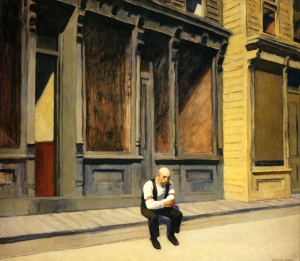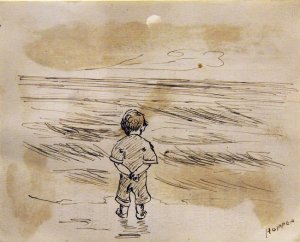It seems almost everything is likely to summon up some reflection upon the nature of Shakespeare, man and artist. For example, this weekend in our town of Nyack, NY we paid a visit to Hopper House, the birthplace of artist Edward Hopper (1882-1967), and noticed a sketch he had made at the age of nine. It’s a portrait of himself viewed from behind (an unusually sophisticated perspective for such a young boy), and the feeling it conveyed was one of isolation, aloneness, loneliness amid the vastness of beach, water and universe:
Then we looked at some of Hopper’s mature work, which immediately made us realize that his portraits of other people conveyed that same isolation and aloneness. Ah, yes, of course, we thought – he was drawing and painting others, but in some fundamental way they were all (again and again) portraits of himself:
 And so, too, I thought, Shakespeare’s “portraits” or characters created for the stage must have reflected aspects of himself – some more fully than others, but all of them parts of his own makeup.
And so, too, I thought, Shakespeare’s “portraits” or characters created for the stage must have reflected aspects of himself – some more fully than others, but all of them parts of his own makeup.
In our public library we took out a few books, among them Man in Profile: Joseph Mitchell of The New Yorker by Thomas Kunkel (2015), and on a separate page before the table of contents was a quote from Oscar Wilde in The Picture of Dorian Gray: “Every portrait that is painted with feeling is a portrait of the artist, not of the sitter.”
Then the next day, Sunday, we looked at The New York Times Book Review and its front-page review of Bearer of Witness: The Complete Works of Primo Levi, edited by Ann Goldstein, and saw that the reviewer, Edward Mendelson, quoted Levi as saying, “If I hadn’t had the experience of Auschwitz, I probably would not have written anything.” He emerged from Auschwitz with a “need to tell,” to bear witness, because the memories “were burning inside me.”
Such is not the traditional conception of the Stratford man as Shakespeare, given that his life as actor-writer is free of virtually any record of interactions with others. On the other hand, such would have been very much the case with Edward de Vere, Earl of Oxford, given the multitude and diversity of his recorded experiences with others. Only a man with a “need to tell” would have written the Shakespearean tragedy of Hamlet, I thought, and in many ways the character of the noble Prince must have been a portrait of his creator.
Such were some Bard-musings of the weekend…

Hi Hank, When I am less tired & have a bit more time I would love to go into the sonnets with you, but for now……it is late in the evening……I would like to ask you if you think it was really possible that one man, namely WS could possibly have produced out this massive amount of sophisticated thought, poems, sonnets, plays? With the exception of some sexual worm holes, he tapped into almost every human experience, transcending time, space, universe, heavenly thoughts, basic thoughts i.e. Joyce’s Portrait of an Artist as a Young Man…..that make our minds spin & spin. Where did all this begin? Did not a god create the god who sees over us and what was before that? Time, space, bending of light…..What’s it all about Alfie?!!!! Hahahahaha!!!! When all is said and done, we don’t know who we are, where we are going and what we correctly should be doing? Do you? Merry Christmas Hank! Cheers, Peter Weisz 😉
Ah, such large questions, my friend! On the matter of Shakespeare and the enormous body of work, Oxford had a ready audience from a young age, with the Chapel Children performing for the Queen and then the Chamberlain’s Men under Sussex — all through the years, with the court being the primary focus until the commercial theater began to thrive, but even then, still, the demand for plays at court. Oxford had the time to write, and the tools, along with the motivation, and in the 1580s there was strong motivation to turn out history plays to promote loyalty and patriotism in the face of the coming Spanish invasion. Oxford had a kind of studio of writers, personal secretaries who took dictation — Lyly, Munday, Watson, and so on, what Nashe called a “college of writers” in a separate building, a mansion, nicknamed Fisher’s Folly — a huge place in London, so he was not alone — more like the master of a studio the way Michelangelo had a team of sculptors and artists. Moreover Oxford was always anonymous as a playwright, adopting the Shakespeare pen name very late in life, at age 43 in 1593, and that was first only for the narrative poems — anonymity providing a strong inner motive to express oneself through writing, through character, etc. And there’s more. But as for the bending of light and Alfie’s question, there are no answers, only good questions, leading to more questions, and of course the unseen world that is so much larger than whatever we can hope to comprehend… Merry Christmas, Peter.
Dear Hank,
Such a sensitive approach to the Authorship Question, to me it is also as if I were looking at Oxford when he learned of his father’s death: that sense of loneliness on the one hand and of responsibility bearing heavily upon him. We feel the same weight when reading the Sonnets – or Hamlet – when we realize out of what experience in the author this was born. I have a similar experience in front of van Gogh’s spiraling ‘Starry Starry Night’ (sung by Don Mclean in ‘Vincent’): what went on in his mind when he painted this? Painting and depicting a scene, a life, are so close together…
Thank you very much.
Jan Scheffer
PS My comments on your and Peter Rush’ insightful ‘Hidden in Plain Sight’ are forthcoming.
Thank you, Jan. Always good to hear from you, and to see you at the conference. Yes, I share those feelings with you — the Van Gogh paintings, yes, and Mclean’s song in conjunction. In the case of Hamlet, it gets so close to “the author speaking through his character” in the soliloquies perhaps especially. It also occurs to me that Oxford’s female characters are strong, well, first because strong women were very much part of his world, in England and Italy and France, and second because they, too, are self-portraits to one degree or another. Portraits of parts of oneself. Anyway, this does get us beyond the intellectual side of the authorship investigations, and more into an intuitive side, eh? With a smile, thanks again.
Good stuff. Thanks Hank – it’s always a pleasure to read your notes and think of you.
Verily Yours,
Ben August
>
Thanks, Ben! Hope all is well for you these days! Feedback much appreciated.